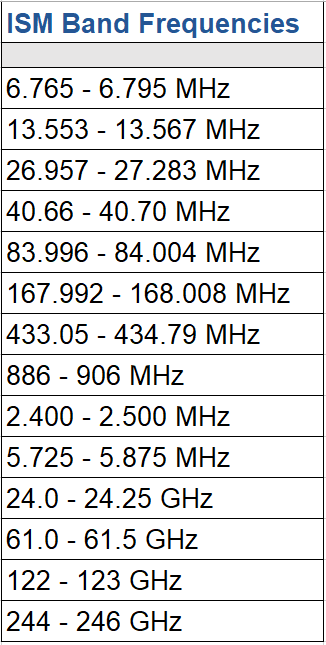The Industrial, Scientific, and Medical (ISM) frequency bands are designated radio frequency bands as defined by the ITU Radio Regulations. These frequency bands were set aside for RF use for purposes other than telecommunications. Hence, using the ISM bands for telecommunications is possible, but telecommunications devices using these frequencies must be able to withstand the interference from other RF and microwave technologies, such as microwave ovens, RF heating, and other potentially electromagnetic interference (EMI) producing devices. Though the ITU determines the international band designations, individual countries exact ISM band frequencies may differ.
Though originally set aside for non-communication purposes, many short range, low power, license-free, or unlicensed error-tolerant communications systems operate within the ISM-band. Of the most common uses outside of communications, are induction heating for industrial and home applications, microwave heating for industrial and home applications, and RF and microwave heating for medical purposes, such as diathermy, hyperthermia therapy, and RF/microwave ablation. Recently, there have also been radar systems developed that operate in the ISM bands, specifically the 2.4 GHz ISM band, due to the readily available and inexpensive wireless ICs available for these frequencies.
The most common everyday uses of the ISM bands are for low-power and short range telecommunications, such as WiFi, Bluetooth, Zigbee, wireless telephones, RFID, and NFC. Many in the US are familiar with the 2.4 GHz ISM band, as most WiFi and Bluetooth communications operate in these bands, though more recently, 5 GHz WiFi systems have become more available. There are also many common RFID and NFC systems that use 13.56 MHz in the 13.553 MHz to 13.567 MHz ISM band, and many credit cards, secure access, personnel identification, and wireless payment systems use these technologies.
Moreover, many of the latest smart home and hobbyist electronics use Zigbee technology in the 915 MHz and 2.4 GHz ISM bands for low-power and short range communications between devices. In the next few years, it is likely that 60 GHz WiFi (WiGig, known as IEEE 802.11ad), operating in the 60 GHz ISM band, will gain popularity for extremely high throughput device-to-device communication. Some examples of this application may be high definition, 4k, video streaming and extremely fast device-to-device wireless data transfers.
There have been many more modulation schemes and communications platforms targeted for the ISM bands emerging in the past few years than prior years. Some of the reasons for this could be the increased potential of The Internet of Things (IoT) and Industry 4.0 applications, which will likely rely on low-power and short range machine-type communications without users being directly involved. Examples of these new technologies include Thread, Z-wave, LoRa, and NB-IoT. Though future applications of ISM bands may include satellite communications, right now there are no available ISM bands available for current cubeSATs, nanoSATs, or other smallSATs.





 Pasternack Blog
Pasternack Blog
